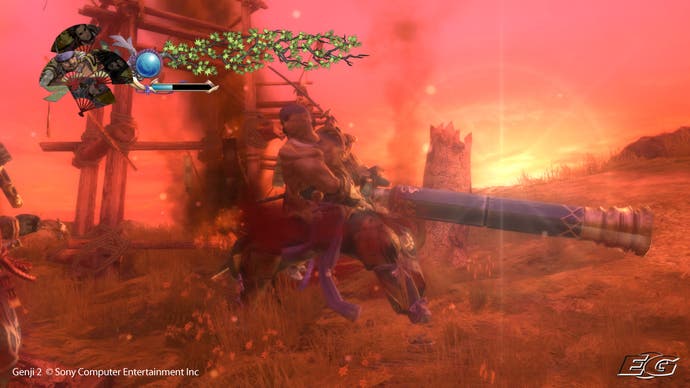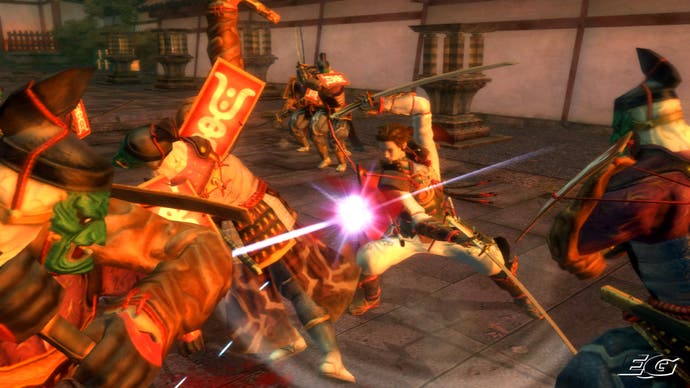Genji: Days of the Blade
Less massive damage than expected.
I'm not sure if this is going to work out. Sure, it's beautiful - stunningly beautiful, in fact - but there's just so much baggage. For all her sultry good looks, I just can't forget that time when she stood there with another man - men! - in front of the world. All those words, all those phrases, they all keep popping into my head - and I know that she's always going to be associated with him, and with the words that they shared. It's just difficult to find perspective.
Especially when the other men are Sony studio boss Phil Harrison and SCEA president Kaz Hirai, and the words in question are "(historically accurate) giant enemy crab" and "flip it over and hit the weak spot for MASSIVE DAMAGE!"
They were all part of a cringe-worthy E3 demo that delivered Genji: Days of the Blade - a sequel to last year's relatively nondescript PS2 slash-'em-up - into a scabrous arms of people who wanted a PS3 poster child for all the wrong reasons. And months of ridicule, it seems, are pretty serious baggage to bring into any relationship. Even here at Eurogamer, where we try to keep an open mind, there was a little ribbing mixed with some sympathetic noises when Genji landed on my review list. With so many amazing games around at the moment, there was a distinct sense that we'd all just played Celebrity Blind Date and I'd ended up with Vanessa Feltz.
Sakura Sake

The comparison is immediately unfair - whatever failings Genji may have, it's hard to fault the looks of the game. The team at Game Republic has taken the beautiful artwork present in the PS2 title and adapted it beautifully to next-gen hardware and high definition. Natural and outdoors areas are particularly arresting, with foliage and water delivered in a stunning, dreamlike manner that almost renders the scene like a painting. During battle scenes you can see dozens of NPCs fighting far off into the distance, and the visual effect is dramatic and impressive, to say the least.
The playable characters themselves are also a pleasure to behold. Wonderfully detailed and animated with a smooth, fluid feel that really adds to the combat of the game, all four have had care lavished upon them. There's some lovely, subtle use of motion blur when one of them dodges or carries out a particularly rapid attack, which makes the whole scene look much more lifelike - and weapon effects are also noteworthy, with a vast range of different moves and attacks available. The game even highlights particularly good attacks. For example, hitting multiple enemies, dealing extra damage or simply clearing yourself out of a tight corner slows the action down to illustrate your skill in more detail with a slightly washed-out, film stock effect.
Admittedly, there are a few flaws brought about by all this graphical splendour, with the framerate a significant victim. While for the most part the game is consistently smooth, at times it descends into a jerky mess - particularly in cut-scenes (for some odd reason. Surely these would be the easiest bits to optimise?). Along with some peculiarly stilted narrative, including a situation where you're sure the game is about to drop you into a horseback segment only to instead show a brief in-engine cut-scene. It's details like this that give weight to the theory that Genji is a bit of a rush-job.

But Genji looks good. Unfortunately, that seems to be what the development team considered to be the most important element. The gameplay is comparatively neglected, and owes much to its PS2 predecessor - a game widely criticised on account of the fact it was so easy that you could complete most of it by just hammering the square button throughout. Thankfully that's not a criticism that you can level at the PS3 sequel, with a more intelligently pitched difficulty curve and a diversity of moves that actually matter, but there certainly are problems that linger.

